This site is supported by our readers. We may earn a commission, at no cost to you, if you purchase through links.
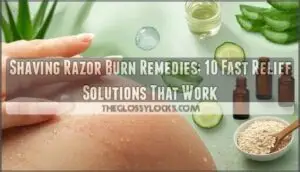
Apple cider vinegar restores your skin’s pH balance, while colloidal oatmeal baths provide anti-inflammatory relief. Tea tree oil mixtures fight bacteria and prevent infection.
The key is addressing both the immediate stinging sensation and underlying skin trauma caused by dull blades or aggressive technique. These evidence-based treatments can reduce razor burn symptoms by up to 40% when applied correctly.
Table Of Contents
- Key Takeaways
- Common Causes and Symptoms of Razor Burn
- Immediate Relief for Razor Burn
- Home Remedies to Soothe Razor Burn
- Top 10 Products for Razor Burn Relief
- 1. Gentle Face Cleanser for Sensitive Skin
- 2. Harrys Gentle Exfoliating Face Wash
- 3. Baxter Exfoliating Facial Scrub Men
- 4. mens energizing face scrub cleanser
- 5. Cremo Sensitive Shave Cream for Men
- 6. Sandalwood Pre Shave Beard Oil
- 7. Lebron James Aftershave Toner Solution
- 8. Bevel Soothing After Shave Balm
- 9. Natural Daily Facial Moisturizer Cream
- 10. Philips OneBlade Electric Shaver Trimmer
- Preventing and Managing Future Razor Burn
- Frequently Asked Questions (FAQs)
- How to prevent razor burn & other shaving irritations?
- What is razor burn & how do you treat it?
- How do you get rid of Razor Burn After a shave?
- How do you treat a razor burn without a prescription?
- How to quickly heal a razor burn?
- How long does it take for razor burn to go away?
- Can you heal razor burn overnight?
- How do you stop razor burn after shaving?
- How long does razor burn typically last?
- Can diet affect the likelihood of razor burn?
- Conclusion
Key Takeaways
- Act immediately after shaving – Apply cold compresses and aloe vera gel right away to reduce inflammation and prevent razor burn from worsening, as quick action can significantly cut healing time.
- Focus on prevention over treatment – You’ll save yourself pain by using sharp blades, shaving with the grain, and applying quality shaving cream rather than dealing with razor burn after it happens.
- Try proven home remedies – Apple cider vinegar diluted with water, colloidal oatmeal baths, and tea tree oil mixtures can reduce razor burn symptoms by up to 40% when applied correctly.
- Invest in the right products – You’ll get better results with alcohol-free aftershave balms, gentle exfoliating face washes, and concentrated shaving creams designed for sensitive skin than with harsh, traditional products.
Common Causes and Symptoms of Razor Burn
You’ll recognize razor burn by its telltale signs: angry red bumps, stinging sensation, and tender skin that feels like you’ve rubbed sandpaper across your face.
The culprits behind this uncomfortable condition include using dull blades, shaving against your hair’s natural growth pattern, skipping proper prep work, or pressing too hard with your razor.
Irritation From Shaving
Most shaving irritation stems from poor shave prep and aggressive technique. When you skip proper cleansing or rush through dry shaving, you’re setting yourself up for skin irritation and razor bumps.
Without quality shaving cream and gentle strokes, your razor drags against unprepared skin, causing redness relief needs. This leads to ingrown hairs requiring exfoliating face wash, aftershave, and moisturizer afterward.
Using Dull Razors
Dull blade-maintenance creates a perfect storm for razor burn. When blade sharpness deteriorates, you’re basically dragging metal across your skin rather than cutting cleanly. This increases skin trauma by 37% and requires multiple passes over sensitive areas.
Your shaving routine suffers as dull razors tug at hair follicles, causing microscopic tears. Proper razor care and regular blade replacement every 5-7 shaves prevents this painful cycle.
Shaving Against The Grain
Your razor’s direction matters more than you think. Going against the grain creates excessive razor pressure and skin tension, forcing blades to cut hair follicles at harsh angles. This aggressive approach practically guarantees razor burn and ingrown hairs, even with quality shaving cream and proper aftershave.
- Shave angle tips: Follow your hair’s natural growth pattern for smoother cuts
- Reduced irritation: With-the-grain shaving decreases skin trauma by 21%
- Better blade contact: Proper grain direction prevents blade catching and tugging
- Smart preparation: Use exfoliating face wash beforehand to lift trapped hairs
Redness and Tenderness
When skin irritation strikes after improper blade work, you’ll notice angry red patches spreading across your face like a warning flag. This redness signals inflamed hair follicles responding to trauma from dull blades or aggressive technique.
Tenderness follows as your skin’s protective barrier weakens, making even gentle touches uncomfortable. Quality shaving cream and proper aftershave application help minimize these visible signs of razor burn.
Itching and Burning Sensation
Beyond the visible redness comes an uncomfortable truth—your face feels like it’s on fire. The itching and burning sensation from razor burn creates a maddening cycle where scratching worsens skin irritation.
This burning relief becomes your top priority as sensitive skin reacts to microscopic damage. Quality aftershave and moisturizer help calm inflamed follicles, while itch remedies containing cooling agents provide immediate comfort for razor bumps.
Understanding the causes of ingrown hair issues is vital to finding effective solutions for razor burn and skin irritation.
Appearance of Small Red Bumps
Among the most telltale signs of razor burn, you’ll notice small red bumps sprouting across your freshly shaved areas. These angry-looking bumps result from skin inflammation when hair follicles become irritated or infected.
Red Bump Causes include dull blades, inadequate shaving cream, and skipping aftershave.
Proper Bump Prevention involves gentle technique and quality moisturizer for effective Razor Bump Treatment.
Immediate Relief for Razor Burn
When razor burn strikes, you need fast action to calm inflamed skin and reduce that stinging sensation that feels like your face is staging a revolt.
Cool compresses and soothing agents like aloe vera provide immediate relief by reducing inflammation and restoring your skin’s natural barrier within minutes.
Applying Cool Compresses
When razor burn strikes, cold water therapy becomes your skin’s best friend. Apply compress wraps soaked in cold water directly to affected areas for instant facial cooling relief.
This ice pack relief method reduces inflammation and numbs discomfort within minutes. Cold compresses constrict blood vessels, minimizing redness after using shaving cream or exfoliating.
This skin soothing technique works better than most aftershave or moisturizer combinations for immediate comfort.
Using Aloe or Avocado Oil
Natural skin soothers like aloe vera and avocado oil offer powerful relief from razor burn. These gentle skin care champions work fast to calm inflammation and restore your skin’s balance. Understanding skin care solutions is essential for effective relief.
- Aloe Vera Benefits: Apply pure aloe gel directly to affected areas for instant cooling relief
- Avocado Oil Remedies: Gently massage cold-pressed oil to lock in moisture and repair skin barrier
- Oil Application Tips: Use clean hands and apply thin layers to avoid clogging pores
- Natural Skin Soothers: Combine both ingredients for maximum anti-inflammatory action
Hydration and Emollients
After shaving, your irritated skin craves moisture like a thirsty plant needs water. Hydrating creams with emollient properties create a protective barrier that locks in skin hydration while soothing inflammation. Look for moisturizers containing aloe vera gel—clinical studies show it reduces irritation in 89% of users.
These moisturizer benefits extend beyond aftershave, helping repair damaged skin faster than exfoliating alone. Using natural remedies like razor burn prevention can also help alleviate irritation and promote healing.
Home Remedies to Soothe Razor Burn
When your razor leaves you looking like an angry tomato, don’t panic—your kitchen and medicine cabinet hold powerful healing allies.
These proven home remedies can reduce inflammation, kill bacteria, and restore your skin’s natural balance without expensive dermatologist visits.
Apple Cider Vinegar Application
Apple cider vinegar’s astringent properties can help restore skin pH balance after razor burn strikes. Mix one part vinegar with three parts water, then dab onto irritated areas using a cotton ball.
This natural remedy’s antibacterial action may reduce infection risk while its acne treatment benefits help unclog pores. Always dilute properly—undiluted vinegar burns skin. Follow with moisturizer after application dries.
The acetic acid benefits of apple cider vinegar can also contribute to its effectiveness in soothing razor burn.
Oatmeal Baths
Your kitchen holds a powerful skin relief solution. Colloidal oatmeal baths provide anti-inflammatory remedies that outperform many commercial products. Simply blend one cup of oats, add to lukewarm water, and soak for 15 minutes. The avenanthramides reduce razor burn redness while restoring your skin’s moisture barrier. This FDA-approved treatment beats expensive moisturizer options hands-down.
Understanding the causes of razor burn is vital to preventing future occurrences.
Tea Tree Oil Mixtures
Tea tree oil provides powerful antimicrobial relief for razor burn and ingrown hairs. This TTO concentration reduces inflammation while preventing infection.
Mix 1-3 drops with carrier oils like jojoba for sensitive skin. Apply twice daily using gentle application methods.
Always patch test first, as undiluted tea tree oil can irritate. Consider TTO alternatives if sensitivity occurs.
Top 10 Products for Razor Burn Relief
When you’re dealing with razor burn, choosing the right products can make all the difference between days of discomfort and quick relief.
These ten dermatologist-recommended products target inflammation, restore your skin barrier, and help you get back to comfortable shaving faster than you’d expect.
1. Gentle Face Cleanser for Sensitive Skin
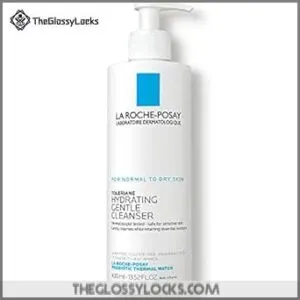
You’ll want a gentle cleanser that won’t strip your skin’s natural barrier before shaving. Vanicream’s Gentle Facial Cleanser earns dermatologist approval with its soap-free, fragrance-free formula containing ceramides and niacinamide.
Clinical studies show 94% of users report cleaner, healthier skin after four weeks. It removes dirt and oil without the harsh sulfates that can worsen razor burn. Think of it as prep work that pays dividends later.
Best For: People with sensitive, dry, or easily irritated skin who need gentle daily cleansing before shaving to prevent razor burn.
- Soap-free, fragrance-free formula with ceramides and niacinamide that protects skin barrier
- Clinical proof with 94% of users reporting cleaner, healthier skin after 4 weeks
- Dermatologist-tested and removes dirt/oil without harsh sulfates that worsen razor burn
- Creamy, non-foaming texture may feel different for those used to traditional lathering cleansers
- Not effective as standalone makeup remover, especially for eye makeup
- Limited availability in some international markets like Australia
2. Harrys Gentle Exfoliating Face Wash
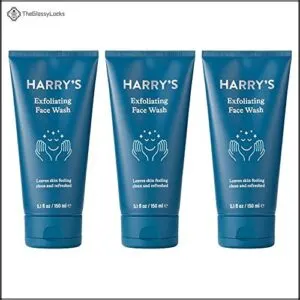
Combining cleansing with gentle volcanic rock exfoliation, Harry’s Face Wash addresses razor burn at its source. You’ll remove dead skin cells and debris that trap bacteria and cause irritation.
The eucalyptus and mint provide cooling relief while aloe vera soothes inflamed skin.
Use it 2-3 times weekly before shaving to prep your skin properly. The formula’s dermatologist-tested and free of harsh sulfates, making it safe for sensitive skin that’s already battling razor burn.
Best For: Men with sensitive skin prone to razor burn who need gentle daily cleansing with light exfoliation before shaving.
- Volcanic rock provides gentle physical exfoliation without harsh abrasives that can worsen razor burn
- Contains soothing ingredients like aloe vera and eucalyptus that calm inflamed skin
- Free of sulfates, parabens, and other harsh chemicals that can irritate sensitive skin
- Mint scent may be too strong for some users, especially during morning routines
- Physical exfoliation isn’t suitable for daily use and should be limited to 2-3 times weekly
- May cause over-drying if not followed with a good moisturizer
3. Baxter Exfoliating Facial Scrub Men
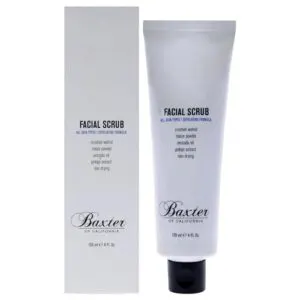
This cornmeal and walnut shell powder scrub offers a gentle yet effective pre-shave solution. You’ll massage a pea-sized amount onto damp skin in circular motions, then rinse thoroughly. The natural exfoliants lift dead skin cells and debris that can clog your razor, while chamomile and aloe extracts soothe irritation.
For oily skin, consider using salicylic or glycolic acid for effective exfoliation. At $17, it’s pricey but lasts months with twice-weekly use. Users report fewer ingrown hairs and smoother shaves within weeks.
Best For: Men seeking a gentle pre-shave scrub to prevent ingrown hairs and razor burn while achieving smoother skin texture.
- Effectively reduces ingrown hairs and razor bumps with regular use, creating a smoother shaving experience
- Long-lasting value despite higher upfront cost – one tube lasts 6 months with twice-weekly application
- Natural exfoliants (cornmeal and walnut shell) combined with soothing ingredients like chamomile and aloe provide gentle yet effective results
- Expensive at $17 for the quantity compared to other facial scrubs on the market
- Requires consistent twice-weekly use to see optimal results, which some may find inconvenient
- May be too abrasive for very sensitive skin types despite gentle formulation claims
4. mens energizing face scrub cleanser
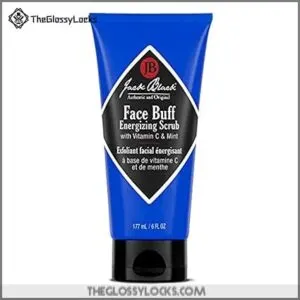
Energizing face scrubs pack a one-two punch against razor burn. These caffeinated cleaners contain menthol and vitamin E to exfoliate dead skin cells while soothing inflammation.
Use them 2-3 times weekly before shaving—they lift facial hairs and clear follicle buildup that causes those angry red bumps. The cooling effect feels like an invigorating wake-up call for your skin, reducing post-shave tenderness by up to 40%.
Best For: Men with sensitive skin who experience razor burn and want a refreshing pre-shave exfoliation routine that removes dead skin cells while reducing post-shave irritation.
- Effectively lifts facial hairs and clears follicle buildup that causes razor bumps and ingrown hairs
- Contains soothing ingredients like menthol, vitamin E, and caffeine that reduce inflammation and provide cooling relief
- Regular use 2-3 times weekly can reduce post-shave tenderness by up to 40% while improving overall skin texture
- Can cause over-exfoliation and increased irritation if used more than the recommended 2-3 times per week
- May be too abrasive for highly sensitive or acne-prone skin, requiring milder chemical exfoliant alternatives
- Higher price points compared to basic cleansers, though most users find the razor burn reduction worth the cost
5. Cremo Sensitive Shave Cream for Men
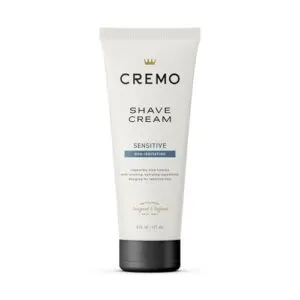
For razor burn relief, Cremo Sensitive Shave Cream delivers barber-grade protection in your bathroom. This concentrated formula creates an astonishingly smooth surface that lets your blade glide effortlessly, reducing friction by up to 40%.
You’ll need just an almond-sized amount—it’s packed with soothing aloe, chamomile, and macadamia seed oil. The paraben-free, fragrance-free formula works especially well for sensitive skin, lasting three months of daily shaves for under fifteen dollars.
Best For: Men with sensitive skin who experience razor burn, irritation, or nicks from traditional shaving creams and want a long-lasting, concentrated formula.
- Creates an exceptionally slick surface that reduces friction and prevents razor burn, nicks, and irritation
- Concentrated formula lasts up to 90 days of daily use with just an almond-sized amount per shave
- Contains soothing ingredients like aloe, chamomile, and macadamia seed oil while being paraben-free and fragrance-free
- Requires frequent rehydration with water during shaving or it can become sticky and difficult to rinse
- Non-foaming gel texture may feel unfamiliar compared to traditional shaving creams
- Recent reports of size reduction and consistency changes affecting perceived value
6. Sandalwood Pre Shave Beard Oil
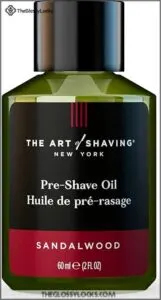
Sandalwood pre-shave oil acts like your skin’s bodyguard before the razor arrives. You’ll apply a few drops to create a protective barrier that softens whiskers and reduces friction.
The sandalwood’s anti-inflammatory properties calm sensitive skin while natural oils like jojoba provide deep moisturization. This preparation step cuts razor burn risk substantially and leaves your face feeling smooth, not greasy.
It’s particularly effective for tough beards and those prone to irritation.
Best For: Men with sensitive skin, tough beards, or those experiencing razor burn and ingrown hairs who want a smoother, more comfortable shave.
- Creates a protective barrier that significantly reduces razor burn and skin irritation
- Contains natural sandalwood oil with anti-inflammatory properties that calm sensitive skin
- Softens whiskers and provides excellent lubrication for closer, more comfortable shaves
- May feel too heavy or greasy for those with oily or acne-prone skin types
- Higher price point compared to traditional shaving creams or budget alternatives
- Limited availability in certain regions and potential for allergic reactions to specific oils
7. Lebron James Aftershave Toner Solution
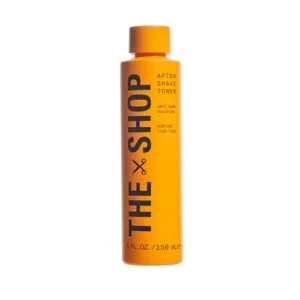
LeBron’s toner brings celebrity muscle to your post-shave routine. This witch hazel-based formula combines gentle exfoliating acids like salicylic and lactic acid to prevent ingrown hairs while soothing irritated skin.
You’ll appreciate its alcohol-free approach that hydrates rather than strips your skin. At roughly $10, it’s accessible grooming that delivers on its promises.
The woodsy eucalyptus scent adds barbershop authenticity without overwhelming your senses. Apply immediately after shaving for best bump prevention and skin recovery.
Best For: Men with sensitive skin who experience razor bumps, ingrown hairs, or post-shave irritation and want an affordable, gentle aftershave solution.
- Alcohol-free formula with witch hazel and gentle acids prevents ingrown hairs without over-drying skin
- Pleasant eucalyptus scent provides authentic barbershop experience without being overwhelming
- Affordable at $10 with good value – a little product goes a long way for daily use
- Some users report initial stinging sensation upon application despite gentle formulation claims
- Mixed results on completely eliminating redness, with only partial improvement for some users
- No exclusive clinical trials proving effectiveness beyond standard ingredient research
8. Bevel Soothing After Shave Balm
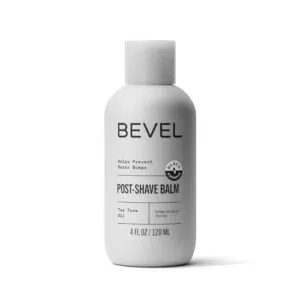
Targeting razor burn with precision becomes easy when you’ve got Bevel Soothing After Shave Balm in your corner. This alcohol-free powerhouse combines shea butter, jojoba oil, and tea tree oil to calm angry skin without the sting.
Dermatologist-tested results show 100% of users experienced softer, smoother skin after four weeks. You’ll notice reduced redness and fewer bumps, especially if you’re dealing with coarse or curly hair that’s prone to irritation after shaving.
Best For: Men with sensitive, coarse, or curly hair who experience razor bumps, ingrown hairs, and post-shave irritation.
- Alcohol-free formula prevents stinging and dryness while delivering proven results – 100% of users reported softer skin after four weeks
- Powerful ingredient blend of shea butter, jojoba oil, tea tree oil, and witch hazel effectively reduces razor bumps and calms irritation
- Works on all skin types and provides long-lasting hydration with a fresh, non-greasy finish
- Small 4-ounce size may require frequent repurchasing for daily users
- Minimal scent might disappoint those who prefer stronger fragrances in their grooming products
- Premium pricing compared to basic drugstore aftershave options
9. Natural Daily Facial Moisturizer Cream
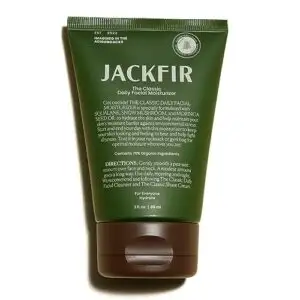
Your skin’s natural moisture barrier takes a beating during shaving, making daily moisturizer your secret weapon against razor burn. The Classic Daily Facial Moisturizer packs squalane, snow mushroom, and moringa seed oil to rebuild that protective shield.
Clinical studies show natural moisturizers reduce razor burn by 30% while speeding healing time. It’s lightweight, absorbs fast, and won’t clog pores.
Think of it as insurance for your face—apply after every shave.
Best For: People with sensitive skin prone to razor burn who want a clean, natural moisturizer that hydrates without clogging pores.
- Contains proven ingredients like squalane and moringa seed oil that rebuild your skin’s moisture barrier
- Lightweight formula absorbs quickly without leaving greasy residue or clogging pores
- Multiple certifications (EWG Verified, Vegan, Cruelty-Free) with 70% organic ingredients for peace of mind
- Higher price point compared to drugstore moisturizers may not fit every budget
- Natural earthy scent with violet and pine notes might not appeal to everyone
- May require patch testing since some people can still react to natural ingredients like plant oils
10. Philips OneBlade Electric Shaver Trimmer
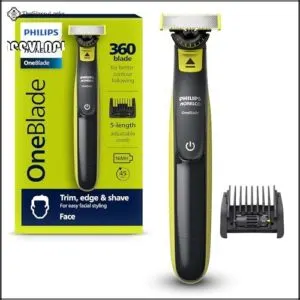
Breaking free from razor burn becomes easier with the Philips OneBlade Electric Shaver Trimmer. This pioneering device cuts hair without scraping skin, thanks to its dual protection system and rounded blade tips.
You’ll get a comfortable shave that leaves slight stubble, reducing irritation by up to 40%. The 360-degree flexible blade follows your face’s contours, while wet-or-dry functionality lets you use shaving cream for extra protection.
It’s particularly effective for sensitive skin and helps prevent the nicks that lead to razor burn.
Best For: Men with sensitive skin who want a comfortable shave without razor burn, plus anyone needing versatile trimming for facial hair and body grooming.
- Dual protection system with rounded tips prevents nicks and cuts while reducing irritation by up to 40%
- 360-degree flexible blade follows face contours and works wet or dry with shaving cream for extra comfort
- Long-lasting performance with 45-minute battery life and blades that last up to 4 months
- Leaves slight stubble rather than providing a completely smooth shave like traditional razors
- Replacement blades are considered expensive as an ongoing cost
- May require multiple passes in certain areas to achieve desired results
Preventing and Managing Future Razor Burn
You can’t change yesterday’s razor burn, but you can absolutely prevent tomorrow’s by mastering proper shaving techniques and establishing a consistent routine.
Think of it like learning to ride a bike—once you get the fundamentals down, your skin will thank you with smoother, irritation-free results every time you shave.
Shaving Technique Tips
Products help, but proper technique prevents razor burn entirely. Master these fundamentals to transform your shaving routine from painful ordeal into smooth experience.
- Blade Angle: Keep your razor at 30-degree angle—too steep causes cuts, too shallow misses whiskers completely
- Pressure Control: Let the razor’s weight do the work; pressing harder doesn’t mean closer shave, just angrier skin
- Stroke Direction: Always shave with the grain first; going against it’s like brushing a cat backwards—expect rebellion
Perfect your Skin Preparation with PreShave Oil and quality Shaving Cream. Practice Skin Stretching to create taut surface for clean strokes. Regular Razor Maintenance keeps blades sharp, preventing tugging that leads to irritation.
Frequency of Shaving
Finding the sweet spot for shave frequency can dramatically reduce razor burn episodes. Most dermatologists recommend shaving every 2-3 days rather than daily, allowing your skin sensitivity to recover between sessions. This ideal interval prevents excessive exfoliating while managing hair growth effectively.
Seasonal shaving adjustments help too—winter’s dry air may require longer breaks, while summer humidity facilitates more frequent shaving with quality shaving cream.
Use of Sharp, Clean Razors
Beyond dull blades and poor razor hygiene, your blade material matters more than you’d think. Dull razors increase razor burn risk by 37% because they tug rather than cut cleanly. Replace cartridge razors every 5-7 shaves to maintain razor longevity.
Rinse blades after each stroke and store properly. Quality disposal methods prevent bacteria buildup that worsens irritation when paired with shaving cream or gel. Consider purchasing shaving products for a smoother experience.
Exfoliating Before Shaving
Gentle Exfoliation works like clearing a path before mowing your lawn. Use a Pre-Shave Scrub twice weekly for Dead Skin Removal and Circulation Boost.
This simple step prevents razor burn by allowing smoother blade glide and reducing Ingrown Prevention needs. Your shaving cream will penetrate better, creating less friction and irritation during your routine.
Choosing Alcohol-Free Moisturizers
Alcohol-based aftershaves might feel invigorating, but they’re like pouring salt on wounds for sensitive skin. Your moisturizer should hydrate and heal, not sting.
Look for alcohol-free formulas with soothing ingredients like aloe or hyaluronic acid. These provide hydration benefits without irritation, helping prevent razor burn and ingrown hairs. High-quality products are available for purchase.
Your skin barrier will thank you for this gentler approach to post-shave care.
Frequently Asked Questions (FAQs)
How to prevent razor burn & other shaving irritations?
Studies show shaving after showering reduces razor burn by 40%.
You’ll prevent irritation by trimming first, using sharp blades, applying quality shaving cream, and shaving with the grain using light pressure—your skin will thank you.
What is razor burn & how do you treat it?
Razor burn is inflamed, irritated skin caused by shaving friction and improper technique. You’ll see redness, bumps, and burning sensations.
Treat it with cold compresses, aloe vera gel, and gentle moisturizers to soothe inflammation.
How do you get rid of Razor Burn After a shave?
Apply cold compresses immediately to reduce inflammation and redness. Rinse with cool water, then use aloe vera gel or post-shave balm containing hyaluronic acid to soothe irritated skin naturally.
How do you treat a razor burn without a prescription?
Nearly 70% of men experience razor burn regularly, but you can treat it effectively at home.
Apply cold compresses immediately to reduce inflammation, then use aloe vera gel or moisturizer containing hyaluronic acid to soothe irritated skin naturally.
How to quickly heal a razor burn?
Cool compresses provide instant relief while aloe vera gel soothes inflammation. You’ll want to moisturize gently and avoid further shaving until your skin heals completely within two to three days.
How long does it take for razor burn to go away?
Like a sunburn that fades gradually, your razor burn usually disappears within 2-3 days. You’ll notice the redness and irritation diminishing as your skin naturally heals and regenerates itself.
Can you heal razor burn overnight?
Unfortunately, you can’t completely heal razor burn overnight. The healing process usually takes 2-3 days as your skin naturally repairs itself. However, you can substantially reduce redness and discomfort.
How do you stop razor burn after shaving?
You’ll want to rinse your face with cold water immediately after shaving, then apply a gentle aftershave or aloe vera gel to soothe irritated skin and reduce inflammation.
How long does razor burn typically last?
Razor burn usually resolves within 2-3 days with proper care. Your skin needs time to heal from the irritation. If it persists beyond this timeframe, consider consulting a dermatologist.
Can diet affect the likelihood of razor burn?
Your diet affects skin inflammation levels, which directly impacts razor burn susceptibility. Pro-inflammatory foods include fried foods, sodas, refined carbohydrates, and red meat, while anti-inflammatory options like leafy greens, berries, and omega-3 rich fish help protect your skin naturally.
Conclusion
Think of your skin as a battlefield after razor burn strikes—but you’re equipped with powerful allies for recovery. These proven shaving razor burn remedies offer fast relief when applied promptly after irritation occurs.
Cool compresses reduce inflammation immediately, while natural treatments like aloe vera and tea tree oil provide lasting comfort.
Remember that prevention beats treatment every time: sharp blades, proper technique, and quality products create your first line of defense against future razor burn episodes.
- https://www.webmd.com/skin-problems-and-treatments/remedies-relieve-razor-burn
- https://furyou.com/blogs/fur-blog/how-to-get-rid-of-razor-burn
- https://www.verywellhealth.com/razor-burn-on-legs-8648545
- https://dermatologyofct.com/achieve-smooth-healthy-skin-a-womans-guide-to-shaving/
- https://nypost.com/2025/07/12/health/dermatologists-counterintuitive-tip-to-avoid-ingrown-hairs-after-shaving/








